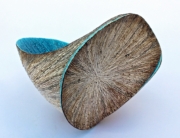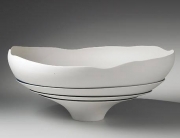The term tokkuri refers to the server that comes with a sake set. More often than not a tokkuri has a bulbous body that forms a tapered narrow neck as one’s eye moves up from the center of the object. Nevertheless, they come in a variety of different shapes.
Heated sake is generally warmed by placing a tokkuri filled with sake on top of a pan of hot water. The narrow neck prevents the heat from escaping.

Tokkuri Sake bottle of the round Mentori shape from the new Kutani period (c. 1820), Photo Credit Ephemeritor
Some particularly classy ryotei restaurants serve sake in metal containers called chirori, but these generally don’t interest yakimono collectors. Glass chirori are sometimes used to chill sake for those who prefer a more modern experience. While these aren’t made of ceramics, a few people have one or two in their collections as a curiosity.
Those shopping around for tokkuri flasks might come across some unusual pieces. The regular tapered tsuru-kubi design is probably the most recognizable. Mentori flasks are more bulbous, and might have a unique primitive look to them despite the fact that they’re still in production in some areas. Western viewers will probably assume that a rosoku tokkuri is some sort of a bottle.
These pieces certainly look very similar to that type of container, and they certainly do serve a similar function. Some westerners might also be confused if they see a kaku-bin, which might almost look like a ceramic box to an untrained eye.
A few pieces used particularly for serving have unique features that give away their function. Karakara tokkuri, which are sometimes referred to as yukanbin pieces, are very obviously used by those who take the consumption of sake quite seriously. Katakuchi might be a bit less obvious to those who haven’t seen them before. Some collectors remark that they’re vaguely like some pieces used by individuals participating in a tea ceremony.
While they are somewhat similar, it would probably offend people if one were to misuse a kakakuchi. In the modern era some people have reused henko and rakyou pieces as flower vases. They’re certainly the right size, and some ikebana experts don’t seem to mind. They are purists who don’t care for any sort of use for sake bottles outside of being used as sake containers, but a few modern artists have produced replicas expressly for the purpose of using them as bud vases.
A few seasoned yakimono collectors are more interested in the exotic varieties of tokkuri sake flasks. Kamo duck style flasks lay on their side, as do the bulbous almost submarine-looking tawara flasks. Kamo and tawara pieces bare little resemblance to the usual western paradigm of what a flask should look like.
That being said no one should think of these styles as mere curiosities, nor should they associate them with modern objects that they superficially look like. Rather, learning to appreciate how many years have gone into making each of these traditions will help collectors to understand just how precious each culture treasure really is.





